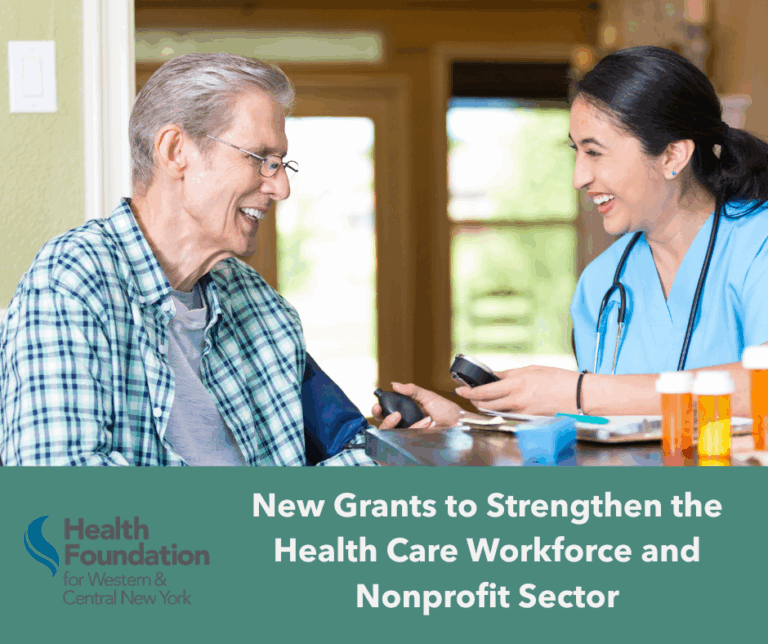Faith leaders and clergy play a complex and important role in their communities, offering comfort, guidance and leadership to congregants, and connecting people to valuable health-related resources and information. The Health Foundation’s work with the faith leader community includes supporting an initiative led by the Ralph C. Wilson, Jr. Foundation that gives faith leaders the opportunity to collaborate on new ways of supporting and reaching family caregivers.
Social distancing guidelines set by the U.S. Centers for Disease Control and Prevention (CDC) are critically important for slowing the spread of COVID-19 and minimizing the strain on hospitals and health systems. This new way of living has also led to challenges for faith leaders in reaching the people they serve.
For example, funerals, memorials and other community rituals are very different now that large groups are unable to congregate. These new limitations also make it more important than ever for faith leaders to reach out to those who are already at risk for social isolation, such as older adults or people with disabilities. We spoke with several faith leaders across western and central New York to learn how they are tackling these challenges.
Sharing Comfort In New Ways
Across religions, faith leaders are turning to technology to help them guide congregants through the grieving process and provide comfort and counsel. Video conferencing software like Zoom, applications like FaceTime or WhatsApp, and Facebook Live videos are being used in faith communities to help leaders connect with members of their community and enable mourners to pay respects in a safe, socially distant way. But technology is only a tool—and faith leaders are finding it takes creativity and dedication to meet the emotional and spiritual needs of their community under these constraints.
Rev. George Nicholas, senior pastor of Lincoln Memorial United Methodist Church in Buffalo, explained how funeral traditions are an important part of the grieving process for many in the African-American community.
“Experiences and culture play a big role in how people grieve. For African-Americans, the grieving process is very much a community process. There’s a great engagement by the entire community when someone dies,” said Rev. Nicholas. He explains that health inequities and the historical and current impact of systemic racism mean the black community is deeply and uniquely connected to grieving.
“Our encounters with grieving in the African-American community are far more prevalent. That ritual and ceremony is part of our existence in America,” said Rev. Nicholas. “Going back to the times of enslavement, the celebratory nature of our funerals was tied to the idea of liberation, and that idea has been passed on from generation to generation. That makes the ritual, ceremony and grieving process all very important. This separation from the ritual has been hard on the entire community.”
Rev. Nicholas is facing the challenge of making funerals and the grieving process as meaningful as possible while adhering to official requirements for social distancing. Currently, New York State is mandating that in-person funerals are limited to the immediate family only, with as few people as possible attending, and that attendees maintain the recommended six feet apart during the ceremony.
Rev. Nicholas, like many other faith leaders, is using video conferencing technology such as Zoom to allow other community members outside immediate family to view funeral ceremonies. While this technology gives people the chance to pay their respects, he recognizes the need for expanding health care resources and services available to congregants as well as faith leaders to address the long-term impact of these changes.
“Pastoral counseling is more important than ever. We need training for clergy to be able to help families deal with death and dying in this more intimate way,” said Rev. Nicholas. “We also need more access to mental health services for our community to help them through the grieving process.”
Imam Mohammed ElFiki of the Islamic Society of Central New York shared that faith leaders can play a unique role in helping their community feel comforted while also communicating the importance of following official health recommendations. COVID-19 restrictions mean that some Muslim traditions around burial cannot always be followed, but he reminds the members of his community that the teachings of Islam also stress the importance of protecting the health and safety of the community.
“Although only a few people can pray together in person at funerals, we are using Facebook Live to share prayers with the wider community. People can pray individually but also be part of the mourning process,” said Imam ElFiki, who is also using email, video conferencing and the ISCNY’s Facebook page to share critical information.
Reaching Out to Reduce Social Isolation Risk
Our new standards of physical distancing have made it more important than ever to reach out to those who are at risk for social isolation, particularly older adults or people with mobility limitations. Social isolation has been shown to increase risk for a number of additional health problems, including cognitive decline, depression, and heart disease.
Phone calls are a valuable way to reach out to people at risk for social isolation, especially those who may not have reliable internet access or are uncomfortable or unable to use apps or other high-tech methods of outreach.
Rabbi Jonathan Freirich of Temple Beth Zion in Buffalo says that he’s seen an overwhelming response from volunteers who want to reach out to those who are at risk for social isolation. Soon after the impact of the virus in our region became apparent, many members of his congregation reached out to Rabbi Freirich to offer their help. They worked together to divide up their list of congregants and contact community members by phone.
“Right now, we’re not doing our usual work. Our work now is connecting with each other,” said Rabbi Freirich. “We’ve reached out to every affiliated member of our community in the past month. More than ever, this has brought us together.” Rabbi Freirich shares that special attention is given to reaching members of the older adult community, including those with dementia or physical limitations, to ensure they have access to their most critical needs.
Tim Saka, board president of the CNY RISE Center, which serves the Turkish Muslim community in central New York, has been using a variety of technology to reach members of the center. In addition to moving prayer services and classes to video conferencing, the center encourages members to stay connected using social media like WhatsApp, a messaging and chat application.
Mr. Saka shares that WhatsApp has given him the opportunity to stay in touch with community members who are at risk for social isolation, and monitor potential risks or problems that people are facing. After one member complained of losing his sense of taste, Mr. Saka alerted him that this was a common symptom of COVID-19 and advised him to follow the official recommendations for monitoring symptoms and self-isolating.
“This particular member of our community lives with his mother, who is in her 70s, so it was important that they were very careful about following the recommendations in order to keep them both safe,” said Mr. Saka.
Rabbi Freirich also noted that he is considering how faith leaders can carry these new ways of communicating forward, even after restrictions change, because they give people who cannot be physically present a chance to take part in community activities.
Key Takeaways for Faith Leaders During COVID-19
“The need for ritual is important, but it does not supercede the need for public safety,” said Rev. Nicholas. “Use your creative gifts to develop something new that will be meaningful while still remaining within these limitations. Stay connected and be intentional about making contact with people who may need help.”
Summary of Resources and Options:
- Explore the use of video conferencing technology like Skype or Zoom or streaming services like Facebook Live to transition services online
- Chat and messaging apps like WhatsApp, Slack or Facebook Messenger can be used to stay in touch with your faith community
- Ensure you are reaching people who may not have internet or be able to use apps; phone trees can help you reach as many members of your community as possible.
- Using these methods, share updates and recommendations from health officials—this can help reduce the spread of misinformation.
- Encourage your community to find new ways of remembering those we have lost, such as planting a tree or perennial flowers in their garden.
Other resources:
WBUR: Coping with Loss and Grief During a Pandemic
Shiva.com: A New Grief: Staying Connected to Help
AARP’s Guide to Social Distancing



